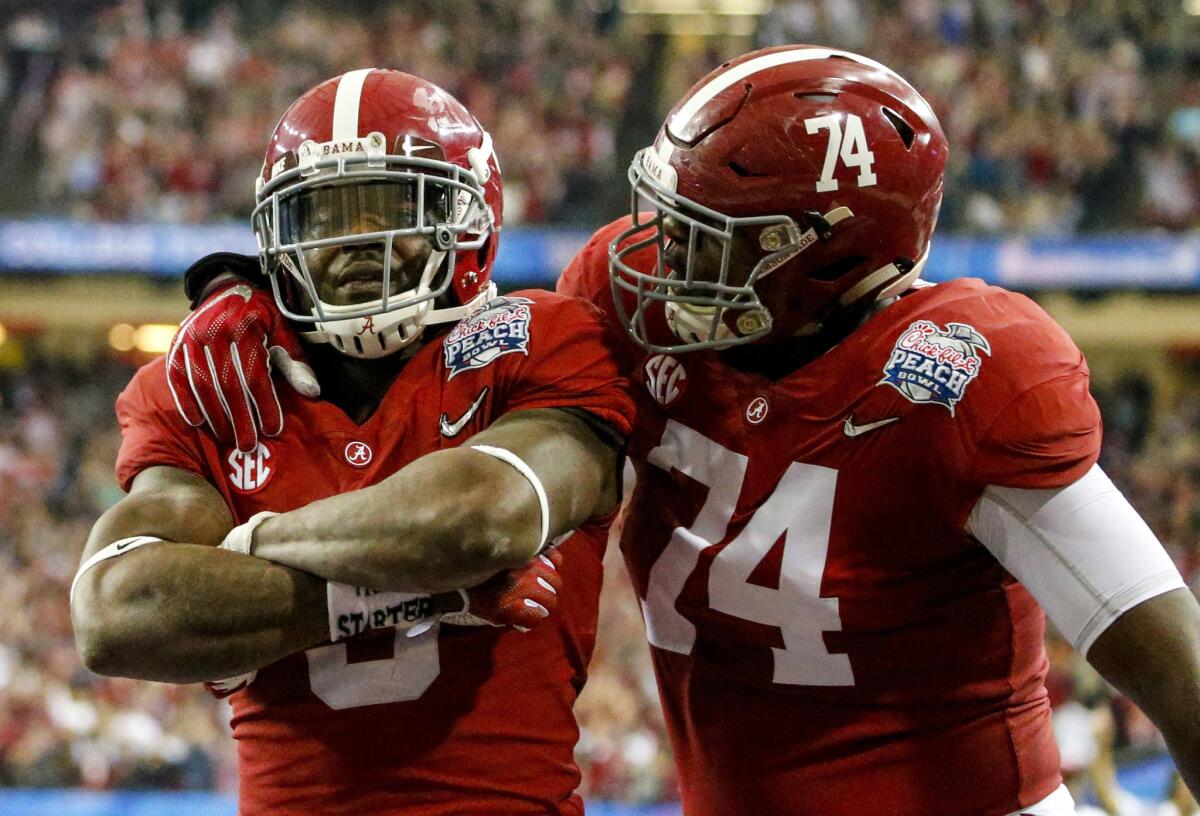Alabama-Clemson is the right title matchup, but that doesn’t mean CFP system is the ultimate solution

- Share via
Reporting from Tampa — Name two better teams to play for the college football championship. I dare you.
Don’t say USC — not after the Trojans gave up 49 points in the Rose Bowl. Don’t say Penn State, which lost that game in Pasadena.
Don’t say Oklahoma or Wisconsin. Certainly not Michigan, which stumbled in its bowl game.
Top-ranked Alabama and No. 2 Clemson clearly deserve to be in the College Football Playoff title game here Monday night.
That doesn’t mean the current system is theoretically the best way to determine a champion. An expanded field — eight contenders, maybe even 16 — might yield a more comprehensive result.
But is the four-team format the best possible solution?
Pleading his case to a small group of reporters in a hallway Sunday morning, Bill Hancock, the head of the CFP, put it this way: “You have to look at the nature of college football.”
The evolution of the postseason — from traditional bowls to the Bowl Championship Series to what we have now — has been fueled by a desire for fairness.
There are compelling reasons for a broader field, which would make room for teams that suffer from bad calls or unlucky breaks during the regular season, not to mention teams that come on strong at the end.
On the flip side, established bowls have fought to keep their relevance and university presidents have publicly fretted about adding more games, reluctant to pull student-athletes away from class.
Given that the NCAA’s basketball tournament stretches about three weeks, the latter concern seems questionable. But March Madness might be the best argument against expansion.
Basketball’s 68-team bracket has sucked the life out of the regular season. The same could happen in football, which has always been special because each week feels like do-or-die.
When Ohio State played Michigan in late November, both teams needed to win to make the playoff. That would not have been the case with a larger field and the Buckeyes’ double-overtime win might not have been nearly as dramatic.
“It wouldn’t have been the same,” Hancock said.
Conference championships could take an even bigger hit.
With an upset loss to Pittsburgh on its record, Clemson knew it had to get past Virginia Tech in the Atlantic Coast Conference title game.
“Everybody is talking about wanting to expand the playoff and all that,” said Jeff Scott, the Tigers’ co-offensive coordinator. “I feel like we’ve been in the playoff ever since that Pitt game.”
Alabama could have played the Southeastern Conference title game confident that a loss to Florida would not knock it out of playoff contention. The stakes might not have been nearly as high in the Big Ten and the Pac-12.
“The postseason and the regular season are bound together,” Hancock said.
Still, Alabama linebacker Reuben Foster knows that some fans — a lot of fans — want change. He understands the benefits of a larger bracket.
“It would give a lot of people opportunities,” he said. “But also bang a lot of people up.”
Foster is talking about the players.
Remember, these aren’t professionals who can devote all of their time to training and recuperating. They are young men — many of them teenagers — who ostensibly spend hours each day attending class and studying. A long season can take its toll.
“Right now,” Foster said, “I can’t imagine playing another game after this.”
As it stands, the teams that just missed the playoffs weren’t exactly relegated to oblivion. They played in major bowl games before big crowds and national television audiences.
Michigan went to the Orange Bowl where it lost to Florida State in a wild finish. Wisconsin defeated upstart Western Michigan in the Cotton Bowl and Oklahoma beat Auburn in the Sugar Bowl.
Good luck to the national championship game if it hopes to outdo USC’s 52-49 comeback victory over Penn State in the final seconds of perhaps the greatest Rose Bowl ever.
“If the bowls were going to be diminished significantly, it would have started with the BCS,” Hancock said. “I don’t see it.”
The CFP is a quarter of the way through a 12-year contract that contains no language for changing the current parameters. The system’s third season concludes with a compelling matchup.
This is a repeat of last year’s thrilling final, when a surprise onside kick sparked Alabama’s 45-40 victory.
The undefeated Crimson Tide rely on a defense that scored an astounding 11 times off turnovers this season and a quarterback, Jalen Hurts, hoping to disprove the old adage that no team can win it all with a true freshman behind center.
On the other side of the field, Clemson is looking for revenge, led by a star quarterback, Deshaun Watson, who many believe should have won the Heisman Trophy this season.
Alabama Coach Nick Saban can make history by winning his sixth national championship — which would tie the record held by Bear Bryant — while Clemson Coach Dabo Swinney is hungry to prove his program belongs among the elite few.
“These are the two best teams and, to be honest with you, I don’t think there’s another team out there that’s capable of beating Alabama,” Swinney said. “I think we’re probably the only team that has a chance.”
Granted, just because the CFP got it right this year, that doesn’t make it perfect.
But it might just be the best answer for college football.
More to Read
Go beyond the scoreboard
Get the latest on L.A.'s teams in the daily Sports Report newsletter.
You may occasionally receive promotional content from the Los Angeles Times.











